“My basic theory with all young event horses is that I want them to go forwards when I ask, and to stay straight over whatever it is I happen to point them at. Especially with the youngsters when I’m starting with them, I tend not to get too concerned about having the perfect distance, I like to just canter around and teach them to start looking for themselves.” Shane Rose tells us how..
Shane Rose is one of the most thoughtful rider/trainers I know, and he has the gift of being able to express himself so clearly… For this working session, he chose a really striking horse as his partner – the imported Hanoverian stallion, Contenda. The young stallion was at the time in training as an eventer as part of his performance test requirements. He had been ridden and competed Christopher Burton before he set sail for his new base in the UK. Interesting that the training session was the first time Shane had actually sat on the horse.
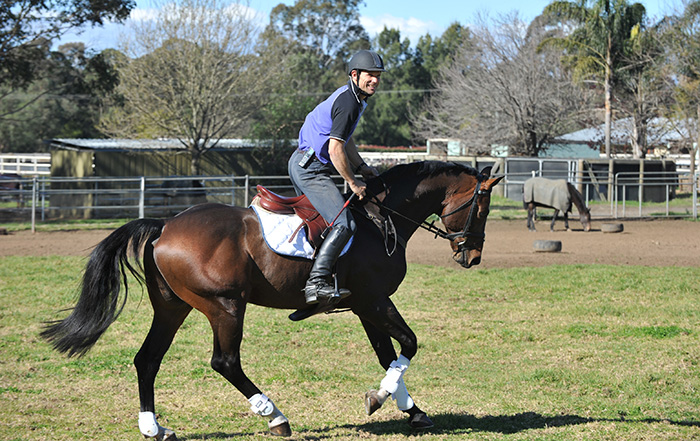
“I don’t try and miss them on purpose, or give them bad distances, but if I see the distance isn’t perfect, I don’t panic over little stuff – it teaches them to start to focus for themselves. That way when you get on cross country, if something is not perfect, they are more able to help you out.”
Do you like to school them over show jumps before you take them out over cross country fences?
“Not necessarily, it depends a little on the horse. If I feel like I need to school them over show jumps first I will, but if I feel like going out in the cross country paddock first up, then I will too. Horses tend to naturally jump logs better than show jumps anyway. I’m not overly fussed either way – if they are some show jumps on the arena, I might pop over them, or take them in the cross country paddock.”
Even when the horse stopped a couple of times, you didn’t get after him?
“No, the first time he stopped, he just got a little confused. The distance wasn’t perfect. The first time he jumped it, I don’t know what he did, he twinged a leg and carried it sore for a couple of strides.
“He twinged a leg and carried it sore for a couple of strides…”
I think he was just unsure why that happened, and that’s why he stopped. I gave him the benefit of the doubt and rode him better the next time. I made sure he got a good distance, to get him confident.”
“The second time, when he ran out on the taller narrow fence – I’m more concerned about that than the stop. When he stopped at the log, it was just a confusion thing, it wasn’t him being naughty. But with the run out, that was a conscious decision, he could jump the fence or take the run out option. So there I didn’t use the stick but I was very firm with my leg, I stopped him running forward and moved him away from my left leg, so that he was very aware that he is not allowed to run through my leg. It was a straightness issue that I was fixing.”
Contenda running out at the roll top
“He’s very good at jumping, that’s not a problem, but for me, they should be unequivocally straight. If I canter to a fence, they have to learn to jump to the middle of it. If they jump the fence but they twist, or drift a little to one way, I treat that as seriously – or more so – as a run out, because the thought of them not jumping straight, is the first thought of having a run out. Even if I am on course, and I jump an apex, and the horse drifts to one side or the other, I will school it on course, to make sure that they know that they have to take off, go over the fence and land in a straight line. It becomes natural to them, and when we get to more difficult lines, they jump, land straight and canter away straight. It means that if you are dealing with angled rails, they have learnt from an early age to jump straight and go away straight.”
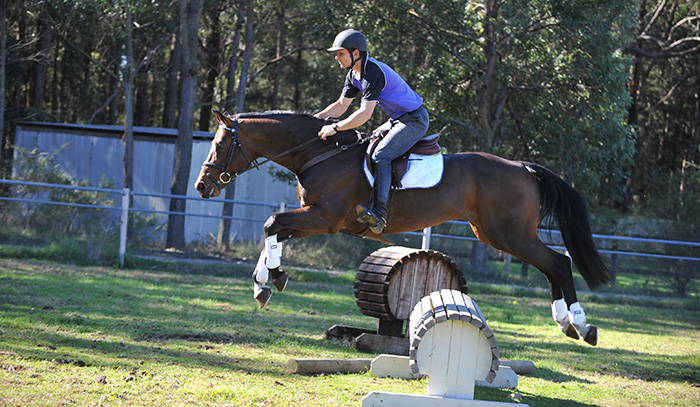
“Today was the first time I’ve jumped this horse. I’ve seen him jump a little, and he is a very fancy jumping horse. I haven’t really seen him cross country. So I started over a few simple logs, just to get a feel for his canter stride and how that all works. Personally, I probably want my horses to take me a little more to the fence than what he was doing at the start. Maybe that was being in a new environment with a different rider, but after the first two or three fences, I wanted him to take me more to the fence, so that I have the option to wait. If he is taking me, and I need to move up to an away distance, it is much better if the horse has got it in its mind that it is going forward.”
“We started over some smaller stuff. He was jumping the logs nicely. We’ve got a ditch that we’ve put some portables around to teach them about the coffin concept. We just jumped the ditch the first time as an open ditch to see what he thought about ditches. He did that really well so we turned back and jumped the ditch one stride to a small roll top. He didn’t quite know what to focus on, the ditch or the roll top. The first time he really hesitated at the ditch, almost trotted over it from a standstill. Again, I wasn’t overly worried about that, I encouraged him to keep going forward, but again he was unsure as to what he was supposed to do, so I just encouraged him.”
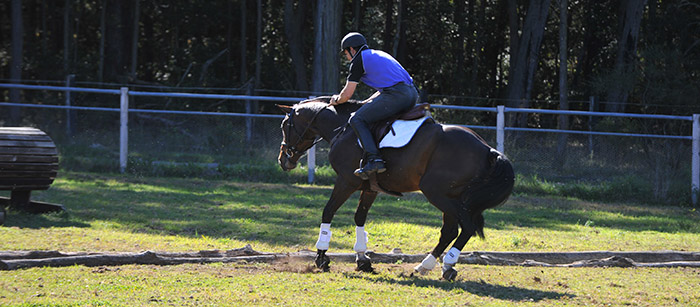
Contenda frightened of the ditch…
“The next time he was much more confident and jumped it quite well. Once he’d jumped the ditch to the roll top, I turned it around, jumped the roll top back to the ditch. He knows that the ditch is there and he can jump it, and that’s not a problem. It is a little more difficult for them to jump something to a ditch, they don’t see the ditch until after they have jump the obstacle in front of it, so it is much more shock value – that’s why we go over the ditch first.”
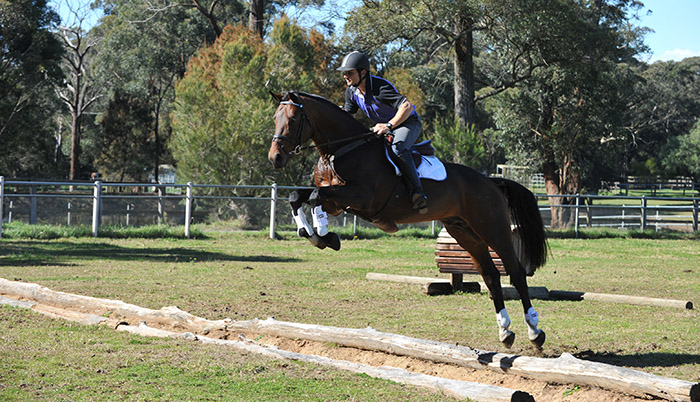
Contenda confident over the ditch the next time
“Once he understood that and was jumping it really well, we went on to some fences that are a little taller and narrower. So for the first time, I used the rails on the narrow fence just to keep him more centred. One jump had two rails and one had one rail – he jumped them really well both directions.
After that we had a little break and I cantered around for a while, then put the two roll tops with the ditch in the middle together, and when he came to the first roll top with just the one wing, he ran out, and I was quite tough on him because he chose not to jump the fence and run to the side.
That’s when I used the correction aid of making him stay straight, making him very aware that he couldn’t go out to the left, even though there was no wing on that side. He had to stay straight. We jumped the other one again just to make sure he stayed confident then came back again and put them together again. Once he understood that he had to jump it straight, he was very good and brave.”
“For me, that was a perfect schooling experience for the young horse. He hasn’t seen a lot, and it is the first time I’ve ridden him. He would have learnt a lot about what I will accept, and what I won’t accept, and what I want him to do. He made a couple of mistakes, that’s great because I could then school them and help him get better, but he certainly finished the session a lot more confident and jumping fences that are at a more difficult level than what he is competing at.”
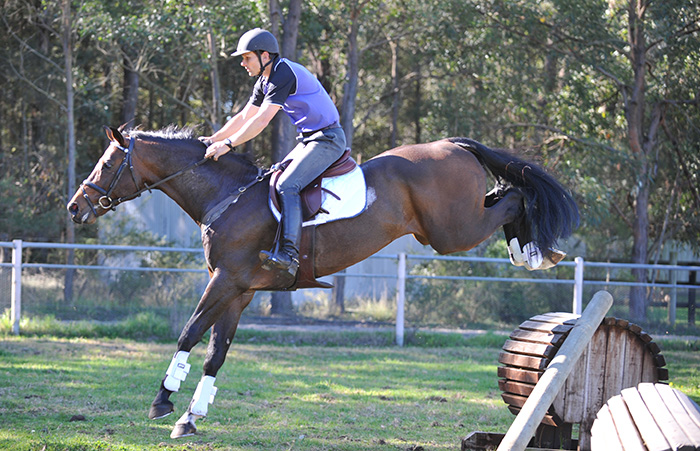
Are cross country horses born or made?
“I think you can make a cross country horse if you school them correctly. The one thing that is really difficult, is when they are worried about ditches. Having said, that a lot of ditchy horses are taught to be ditchy, but there are some that are just ditchy – I had a horse, Bobby Dazzler, who right from the first time he jumped a ditch was absolutely terrified of them. They certainly get better if you school them properly…”
Nikki Richardson was one ditch away from an individual gold medal at Atlanta wasn’t she?
“Nikki Richardson was, and once a horse like Wishful Thinking has developed a real phobia, it is probably the most difficult thing to fix – because a big ditch is a big hole in the ground!”
“The other thing that is very difficult is horses that are very spooky. They will jump the biggest fence in the world, but as soon as they come up to something they are not sure about, that’s a problem. For instance, a log with a slide behind it – some horses will just find that the scariest thing in the world and stop at it, yet they will jump the biggest water complex in the country. It is just the way their mind works, but most horses, if they have the jumping ability, you can teach them to jump cross country.”
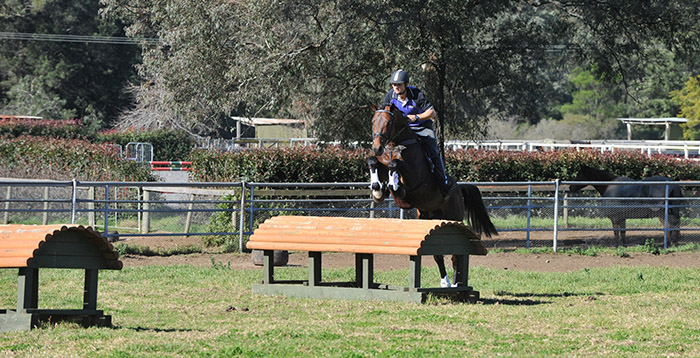
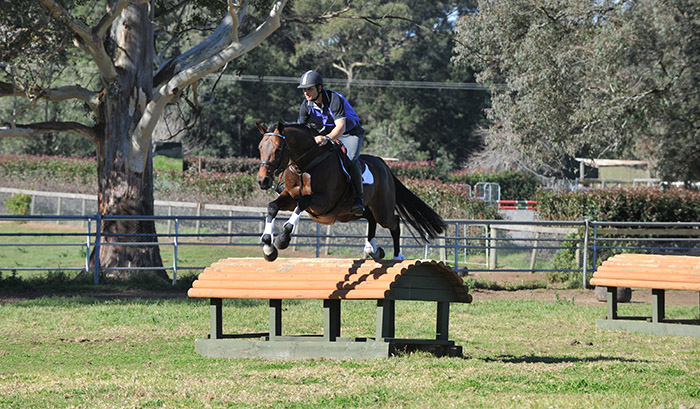
Contenda jumping strong and straight
“The best horses are the ones that enjoy it, horses that are brave, very brave, but adjustable as well. The horses that are most difficult are the ones lacking confidence and bravery. Horses that are strong cross country are really difficult to make time with.”
Thanks Shane, thanks for your time and thoughtful advice – and thanks to Contenda for being such a great photographic model…
Contenda later in his career, on course at Werribee
Breeding eventers in Australia, and want to use the best bloodlines?
Go to www.ihb.com.au and see the great range that’s available.



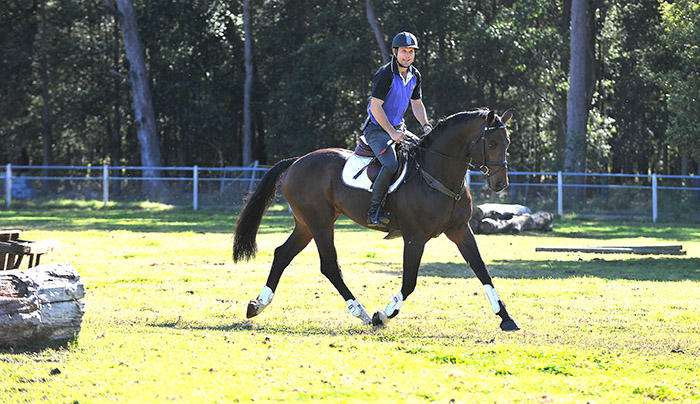
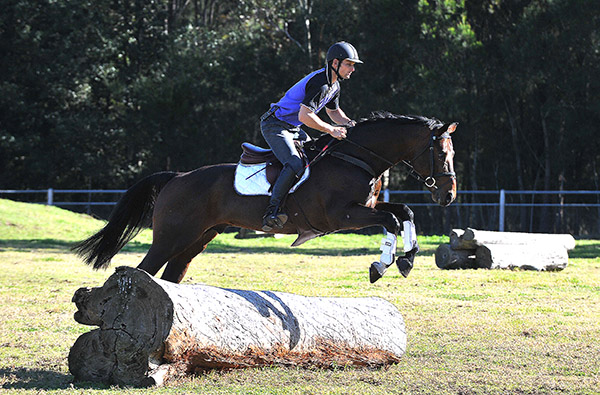
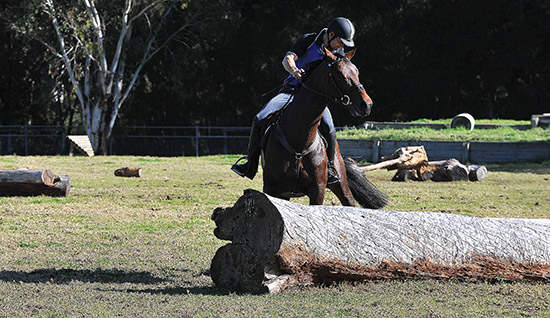
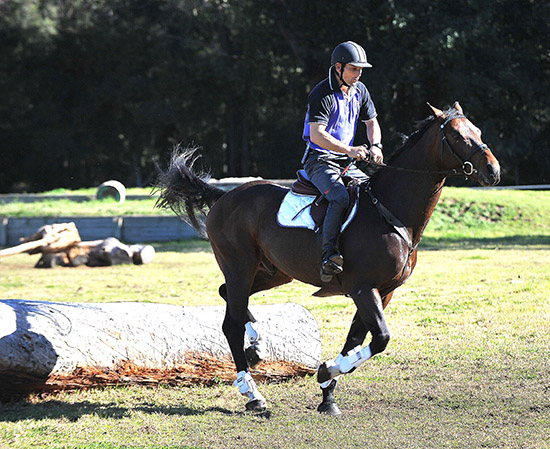
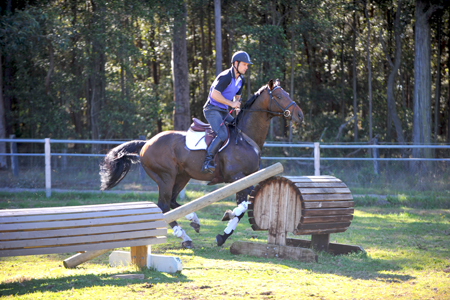
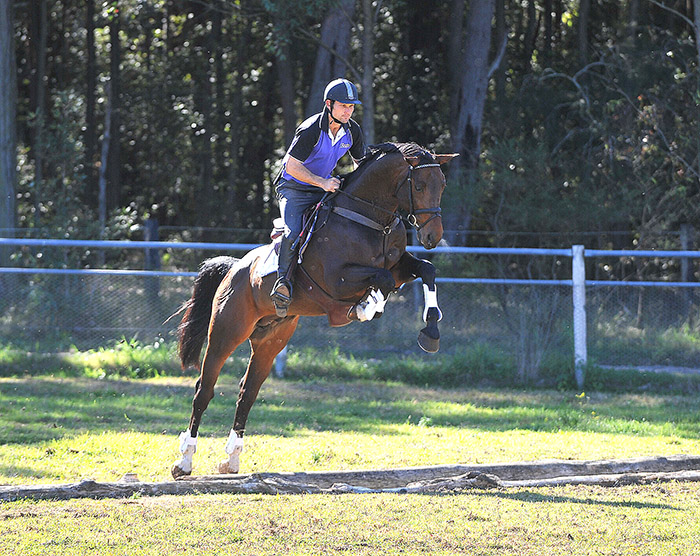
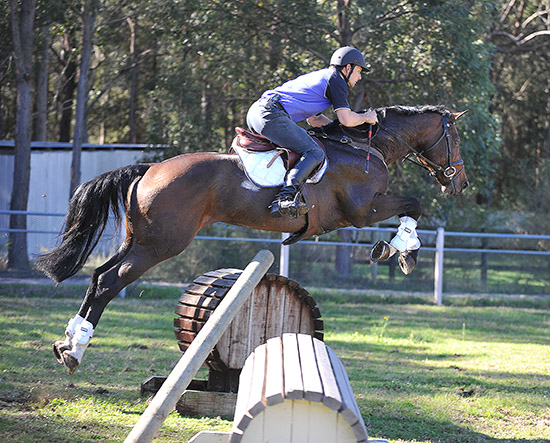
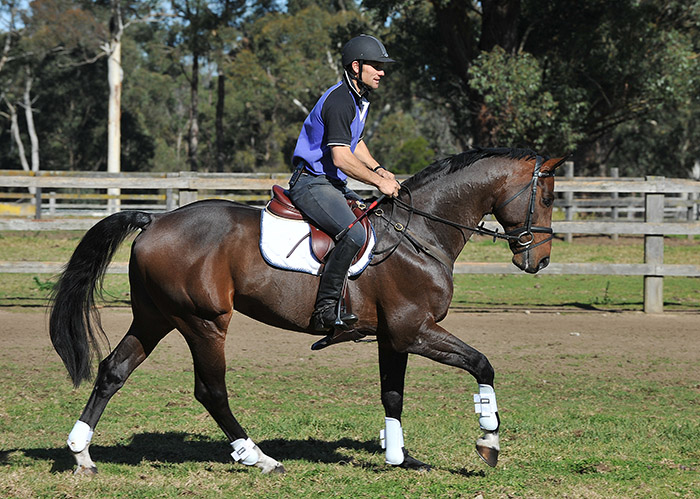
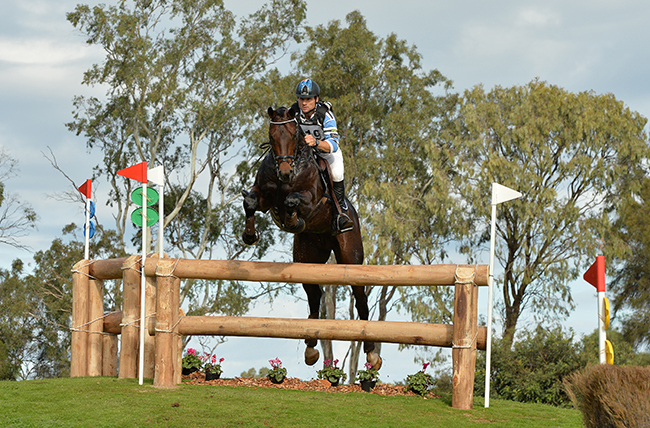
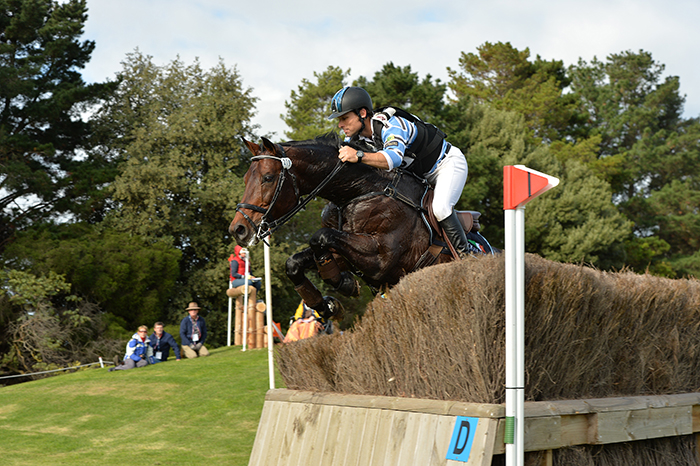
Great read! I would love if someone could further answer the question should you do XC or SJ first on a young horse? If they are quiet and going really well on the flat just go XC? And should you just do small jumps on there first go say 60cm max if all is gong well to keep confidence? Thanks